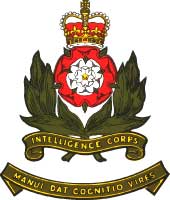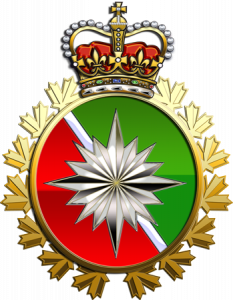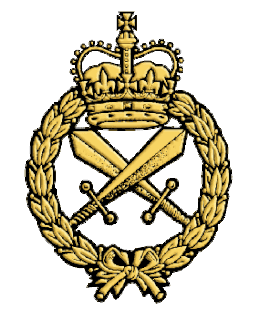
The Namibian Defence Force (NDF) comprises the national military forces of Namibia. It was created when the country, then known as South West Africa, gained independence from South Africa in 1990. Chapter 15 of the Constitution of Namibia establishes the NDF and defines its role and purpose as, " ... to defend the territory and national interests of Namibia".

Defence Intelligence (DI) is an organisation within the United Kingdom intelligence community which focuses on gathering and analysing military intelligence. It differs from the UK's intelligence agencies in that it is an integral part of the Ministry of Defence (MoD) rather than a stand-alone organisation. The organisation employs a mixture of civilian and military staff and is funded within the UK's defence budget. The organisation was formerly known as the Defence Intelligence Staff (DIS), but changed its name in 2009.

The Army Reserve (AR) is the reserve land component of the Irish Defence Forces. It is the second line reserve of the Irish Army. The Army Reserve involves active military service on a part-time basis, and is one of two elements of the Reserve Defence Forces, the other element being the Naval Service Reserve (NSR).

The Royal Military Police (RMP) is the corps of the British Army responsible for the policing of army service personnel, and for providing a military police presence both in the UK and while service personnel are deployed overseas on operations and exercises. Members of the RMP are often known as 'Redcaps' because of the scarlet covers on their peaked caps and scarlet coloured berets.

The Intelligence Corps is a corps of the British Army. It is responsible for gathering, analysing and disseminating military intelligence and also for counter-intelligence and security. The Director of the Intelligence Corps is a brigadier.

An aircrew flying badge is the badge worn on the left breast, above any medal ribbons, by qualified aircrew in the Royal Air Force, Royal Navy, British Army, Indian Air Force, Pakistan Air Force, Royal Canadian Air Force, Royal Australian Navy, Australian Army, Royal Australian Air Force, Royal New Zealand Air Force, South African Air Force and Sri Lanka Air Force. An example of a real Pilot Brevet is as opposite:
The Defence Strategic Policy and Intelligence Group (SP&I) of the Australian Government Department of Defence is responsible for defence diplomacy, strategic policy, international security, and military intelligence co-ordination and advice to the Prime Minister of Australia, Minister for Defence, Secretary of the Department of Defence, and Chief of the Defence Force. The Defence Strategic Policy and Intelligence Group is led by the Deputy Secretary for Strategic Policy and Intelligence and comprises three policy divisions and two intelligence agencies.

The Royal Australian Corps of Signals (RASigs) is one of the 'arms' of the Australian Army. It is responsible for installing, maintaining, and operating all types of telecommunications equipment and information systems. The motto of the Signals Corps is Certa Cito and is translated as 'Swift and Sure', signifying the aim of the signal service – that communication be carried out with maximum speed and certainty. Like their British counterparts, the Royal Australian Corps of Signals' flag and hat badge feature Mercury, the winged messenger of the gods, affectionately referred to by members of the corps as "Jimmy".
The Australian Geospatial-Intelligence Organisation (AGO) is an Australian government intelligence agency that is part of the Department of Defence responsible for the collection, analysis, and distribution of geospatial intelligence (GEOINT) in support of Australia's defence and national interests. The AGO is one of six agencies that form the Australian Intelligence Community.
The Indian military services have established numerous academies and staff colleges across India for the purpose of training professional soldiers in military sciences, warfare command and strategy, and associated technologies.
The Royal Australian Army Educational Corps (RAAEC) is a specialist corps within the Australian Army. Formed in 1949, the corps had its genesis in other services that existed within the Australian forces during World War I and World War II. It is currently made up entirely of commissioned officers and is responsible for the provision of education-related services within the Army. Its various roles include instruction, designing computer-based learning materials, instructional systems, language training, literacy, and numeracy.

The Intelligence Branch is a personnel branch of the Canadian Forces (CF) that is concerned with providing relevant and correct information to enable commanders to make decisions.

Royal School of Military Survey is a joint services survey training facility associated with the Corps of Royal Engineers (RE) but attached to the United Kingdom Defence Intelligence and Security Centre (DISC).

The Royal Australian Survey Corps was a Corps of the Australian Army, formed on 1 July 1915 and disbanded on 1 July 1996. As one of the principal military survey units in Australia, the role of the Royal Australian Survey Corps was to provide the maps, aeronautical charts, hydrographical charts and geodetic and control survey data required for land combat operations.

The Directorate of Military Intelligence is the military intelligence branch of the Defence Forces, the Irish armed forces, and the national intelligence service of Ireland. The organisation has responsibility for the safety and security of the Irish Defence Forces, its personnel, and supporting the national security of Ireland. The directorate operates domestic and foreign intelligence sections, providing intelligence to the Government of Ireland concerning threats to the security of the state and the national interest from internal and external sources.

The Royal Australian Army Ordnance Corps (RAAOC) is the Corps within the Australian Army concerned with supply and administration, as well as the demolition and disposal of explosives and salvage of battle-damaged equipment. The Corps contains clerks, operator supplies, petroleum operators, parachute riggers and ammunition technicians. Members of the Corps are nicknamed Roaches.
The Defence Security Corps (DSC), previously known as Defence Department Constabulary Centre, was founded on 25 February, 1947 at Mathura, Uttar Pradesh. The Defence Security Corps, with 31,000 personnel, provides security at Defence Ministry sites. The role of Defence Security Corps is to ensure the protection and security of designated Defence Installations against sabotage and pilferage. The Central Industrial Security Force (CISF) and the Defence Security Corps (DSC) provide security at Indian Ordnance Factories, India's nuclear laboratories and Defence Research and Development Organisation (DRDO) establishments, respectively. The CISF is purely a paramilitary force under the Ministry of Home Affairs and though the DSC is a force under the Ministry of Defence and it comprises mainly superannuated soldiers who are re-employed for a few years.
The Australian Defence Organisation (ADO) is composed of the armed forces of the Commonwealth of Australia, the Australian Defence Force (ADF), and the Australian Public Service government department, the Department of Defence which is composed of a range of civilian support organisations.

The Royal Australian Corps of Military Police (RACMP) is a corps within the Australian Army. Previously known as the Australian Army Provost Corps, it was formed on 3 April 1916 as the ANZAC Provost Corps. It is responsible for battlefield traffic control, security duties, prisoner of war handling, the investigation of service offences, maintaining discipline and the running of military prisons. Its name was changed in 1918 and it was disbanded in 1920. The corps was reformed during World War II and was granted the "Royal" prefix in 1948, adopting its current name on 4 September 1974. Camilla, Duchess of Cornwall became the first Colonel-in-Chief of the Royal Australian Corps of Military Police in November 2012. The Royal Australian Corps of Military Police have played a role in World War I, World War II and aided in conflicts since the finish of the second world war, including Afghanistan and the Timor Leste Crisis. The Corps have embellishments such as the Governor General’s banner which they received in 2001. As well as specific uniform requirements up to and including their standout scarlet beret. The Military Police has a range of training pathways which leads to the many different specialised roles the members hold.

The New Zealand Intelligence Corps (NZIC) analyses information from a variety of sources and provides commanders with intelligence on such things as enemy locations, capabilities and intentions. Corps personnel also provide advice on Field Security on operations.















